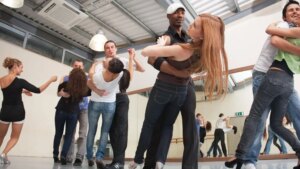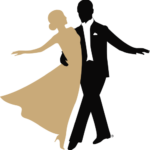At Fred Astaire Dance Studio of Old Town Scottsdale in Scottsdale, Arizona, we believe that dance practice isn’t limited to the studio. In fact, practicing at home can be just as effective for improving your skills, provided you make the most of your time. Whether you’re working on your solo technique or preparing for an upcoming competition, these seven tips will help you take your dance practice to the next level.
1. Create a Dedicated Practice Space
The first step to effective practice at home is setting up a designated space. This doesn’t need to be a large room, but it should be clear of distractions and have enough room for movement. If possible, use a full-length mirror so you can check your posture, body alignment, and movements. A smooth, safe floor is important to prevent injury—avoid practicing on slippery surfaces like rugs or tiles. Creating a space that feels comfortable and free of distractions will help you stay focused during practice.
2. Start with a Proper Warm-Up
Warming up is a key component of any dance practice. Warming up prepares your muscles and joints for more intense movements, reducing the risk of injury. Before you start practicing choreography or routines, spend 10-15 minutes on light cardio exercises like jogging in place or jumping jacks. Follow up with dynamic stretches targeting your legs, hips, and back. Make sure to include stretches that mirror the movements you’ll be using in your practice, such as lunges and shoulder rolls.
3. Break Down the Choreography
When practicing at home, it’s easy to feel overwhelmed by the complexity of choreography. To make learning more manageable, break down the movements into smaller segments. Focus on mastering one section at a time before moving on to the next. Pay close attention to details like foot placement, arm position, and transitions between steps. When you feel comfortable with a section, gradually add the next part and practice connecting them. This will help you retain the choreography more effectively and prevent you from feeling rushed.
4. Practice with a Metronome or Music
Timing is crucial in dance, and using a metronome or music with a clear, consistent beat can help you stay on rhythm. Start by practicing the moves at a slower tempo, focusing on accuracy rather than speed. Once you’re comfortable with the steps, gradually increase the tempo to match the original music. Practicing with a metronome can help you work on your timing and precision, especially for complicated rhythms or fast-paced dances.
5. Record Yourself and Analyze Your Movements
Recording yourself while practicing is a powerful tool for improvement. Watching yourself dance allows you to see areas where you may need to adjust your posture, movement, or alignment. You might notice things that are hard to catch while dancing, like a misaligned foot or a lack of extension in your arms. Recording yourself also lets you track your progress over time and gives you a visual record of your development. Don’t be afraid to critique yourself, but also acknowledge your strengths and celebrate improvements.
6. Stay Consistent with Practice
The key to improvement is consistency. While it may be tempting to skip practice or put it off, staying consistent with your training will yield the best results. Set aside time each day or week for focused practice. Even if you only have 20-30 minutes to spare, daily practice will help you build muscle memory and reinforce the techniques you’ve learned. Consistent practice is essential for mastering choreography, improving flexibility, and building strength.
7. Set Goals and Track Progress
Setting specific goals for your practice sessions will help you stay motivated and focused. For example, you might set a goal to perfect a particular routine, improve your turns, or enhance your posture. Break down each goal into smaller steps and create a plan for how you’ll achieve them. Tracking your progress will help you stay motivated and give you a sense of accomplishment as you see improvement. Whether it’s recording the time it takes to master a routine or measuring improvements in your flexibility, tracking progress will keep you engaged in your practice.
Practicing at home doesn’t have to be daunting or unproductive. By creating a dedicated space, warming up properly, breaking down your choreography, and practicing consistently, you can make significant improvements to your dance skills. At Fred Astaire Dance Studio of Old Town Scottsdale in Scottsdale, Arizona, we encourage our students to make the most of their practice time both in and out of the studio. If you’re looking for more personalized feedback or want to take your dancing to the next level, we offer private lessons, group classes, and competitive training. We’re here to help you achieve your goals, whether you’re preparing for a competition, a performance, or just want to dance for fun.
Ready to improve your dance skills? Contact Fred Astaire Dance Studio of Old Town Scottsdale today at (480) 999-7044 to schedule a private lesson or join one of our upcoming group classes!

